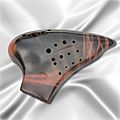Ocarina facts for kids
An ocarina is a kind of flute that is not made out of a tube. Because the ocarina is in a round or box-like shape, its sound is a little different from other flutes.
Contents
History
The ten-hole ocarina was first made by Giuseppe Donati, in Italy, in 1853. Instruments like the ocarina had been made for hundreds of years before that in South America, China, and Africa. In Europe, a form called the gemshorn was made in the 16th century. The gemshorn was made from an animal horn.
In the 19th century, groups of ocarina players, with different sized ocarinas, played classical and folk music. Italian ocarinas became known throughout the world, because of this.
In the United States the ocarina was called the sweet potato, because its shape is like a sweet potato.
In 1928, the Japanese began making ocarinas. They added two small holes to the old kind of ocarinas. Japanese 12-hole ocarinas can play a larger scale than 10-hole ocarinas.
English Ocarina
In the 1960s, the English ocarina was invented. It has four finger holes, and may have one or two thumb holes. English ocarinas are made in many shapes.
Images for kids
-
Sindhi borrindos, a form of vessel flute produced in different sizes to give different tones. The borrindo is made out of soft alluvial clay, plentiful in the central Indus Valley.
-
An Asian double chambered ocarina. The two blow holes in the mouthpiece are clearly visible, which makes it possible for the player to play an extended range of notes (17 in total, in this case from A4 to C6)
See also
 In Spanish: Ocarina para niños
In Spanish: Ocarina para niños
 | Victor J. Glover |
 | Yvonne Cagle |
 | Jeanette Epps |
 | Bernard A. Harris Jr. |






















